by Steve Selden | Nov 21, 2019 | Tour News
November 19 – Warm temperatures and light winds continued today. As the day progressed, conditions became foggy for periods and ultimately soft snow fell near the end of the day. On the tundra, many seals were spotted along the coastline. Polar bears, however, were not seen either on land or on the sea ice. An unusual sighting of an enormous flock of more than 150 ptarmigan kept photographers busy for quite a while. The highlight today, though, was an early morning sighting of two tundra wolves, one black and one gray, seen by groups leaving town at first light. This bear season has been exceptional for wolf sightings; most years no wolves are spotted.

November 20 – It was another snowy day with high winds and cold temperatures. Visibility was reduced to just a few hundred feet for much of the afternoon. Polar bears were not spotted, and very few smaller animals were encountered in the storm. Helicopters were grounded, and all but the main roads in town were closed due to drifting. The storm stopped abruptly at 8 pm, and by 10 pm, groups were gathered outside to enjoy a beautiful northern lights display.
by Steve Selden | Nov 12, 2019 | Tour News
November 9 – The winds died out overnight and the morning temperatures were still cold, just below 0°F. Without the windchill, however, the air felt mild relative to the past several days. Bear watchers reported the highlight of the day was spending the morning with two polar bears along the coast, which were alternating between feeding on kelp and visiting various tundra vehicles. The afternoon was slower for bears, though smaller creatures like American pine marten, ptarmigan and red fox were all spotted. There were more polar bears seen on the sea ice than on land today. The ice bears were viewed from both the tundra vehicles and helicopters. Helicopters reported that more ice had formed in the bay overnight. In just three days, the Hudson Bay has gone from being totally ice-free to having heavy coverage along the coast. The ice now reaches several miles out from the land and is broken up in places by open water.
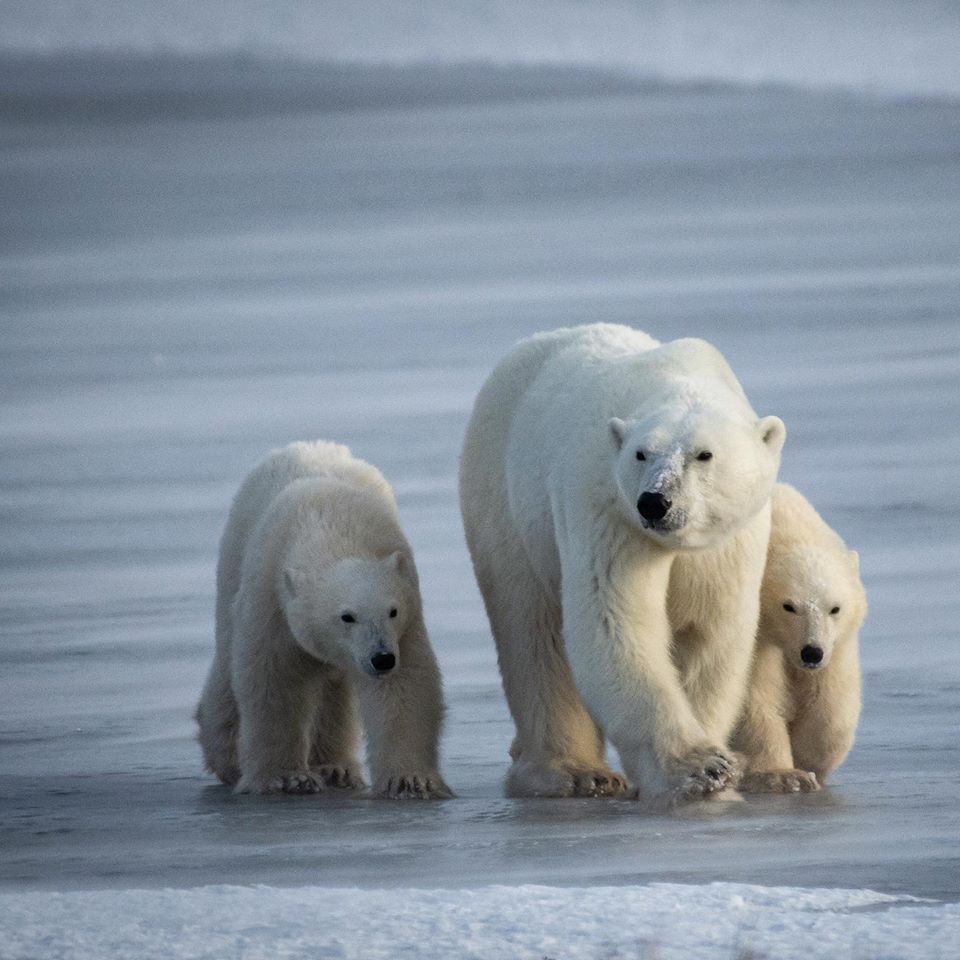
A polar bear and two coys peruse the ice of the Hudson Bay. Discover Churchill photo.
By mid-afternoon, strong winds kicked up from the northwest, causing temperatures to fall. About that time, folks from town gathered at the Polar Bear Holding Facility to watch the release of a sow and two yearling cubs. These bears were flown by helicopter further north and away from town, where they can’t get into any more mischief. With so many locals present, the conversation naturally turned to the quickly changing ice conditions. There were many hopeful comments about how early freeze-ups have occurred in the past during bear season, only to have the ice blown back out by strong winds several days later.

A mom and cub polar bear keep a watchful eye on the tundra. Discover Churchill photo.
November 10- Today was extremely cold with a high of -27°F. Windchill made it feel more like -35°F, and the strong, cold winds persisted throughout the day. Conditions alternated between cloudy and foggy, with periodic whiteouts and blowing snow. The weather made for tough bear viewing. Bear watchers found one bear on the eastern side of the Churchill Wildlife Management Area. It was present all day, resting and rolling around to clean its coat. Many smaller animals were encountered by the tundra vehicles, including Arctic fox, red fox and ptarmigan. A real highlight for some travelers was a sighting of an ermine that had just killed a lemming. It appears from shore that the ice has consolidated more since yesterday. Helicopters were unable to corroborate, however, since they were grounded due to the high winds. Southern winds are expected soon—this often blows the ice out, bringing polar bears back to shore.
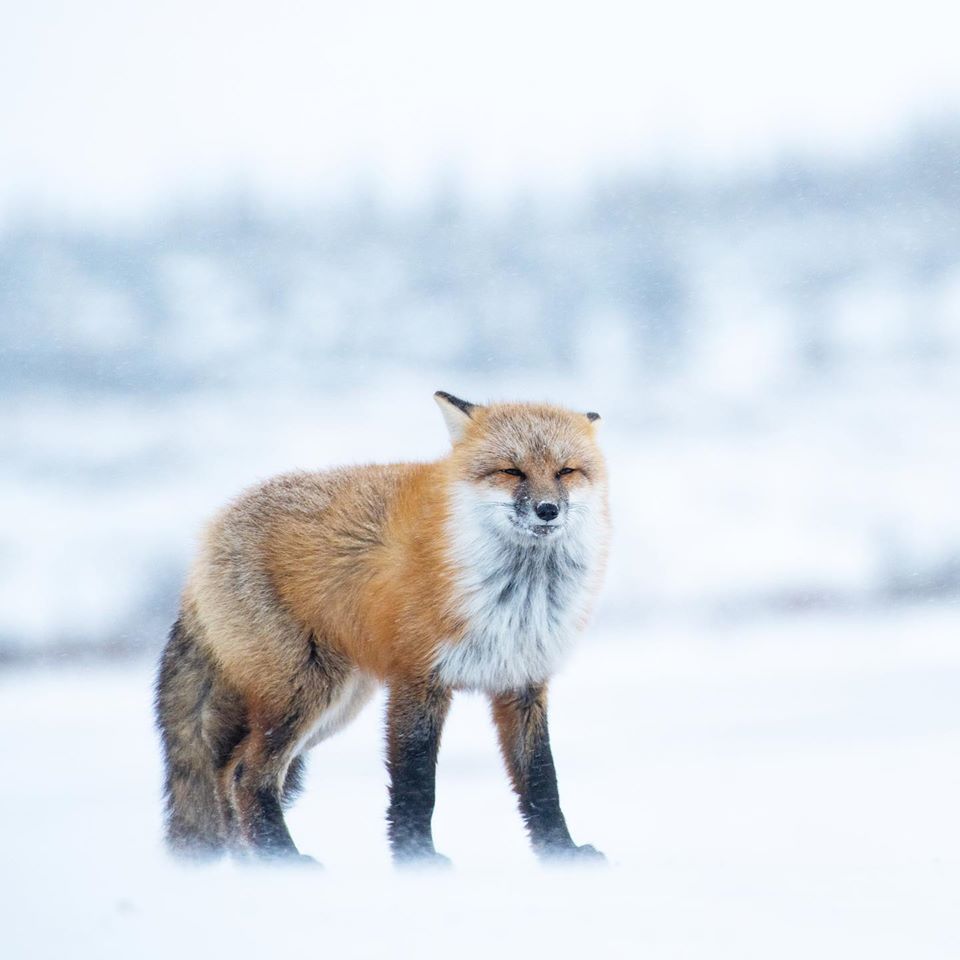
A red fox in the wind and cold in Churchill. Discover Churchill photo.
November 11 – Cold temperatures dominated again today, though, at only -16°F, it felt mild compared to previous days due to less windchill. Winds have shifted to come from the west. Helicopters were back in the skies this morning and pilots reported several polar bears on the ice. Polar bear cubs and a seal kill stole the show, along with a moose cow and calf near the shoreline. By early afternoon, helicopters were reporting that the ice had pushed away from the shore, and polar bears were spotted on land in various locations. From the tundra vehicles, a few bears were observed on the ice from Halfway Point early in the morning, best seen with spotting scopes. By late morning, the tundra machines made it out to Gordon Point to find a sub-adult bear. They watched it for hours as it ate kelp and walked among the vehicles. A red fox was seen on the tundra by several groups, a snowy owl was spotted from the Tundra Lodge, and there have been many red and silver fox sightings right in town. Winds are expected to shift to arrive from the south overnight, and local chatter is that this is the best-case scenario for potentially moving ice out of the region and driving more bears back to shore.
by Steve Selden | Dec 15, 2017 | Tour News
This exceptional post my Natural Habitat Adventures guide Brad Josephs is a story of perseverance and making the best of a situation out of one’s control. An experience can take on a life of its own if the effort is put in!
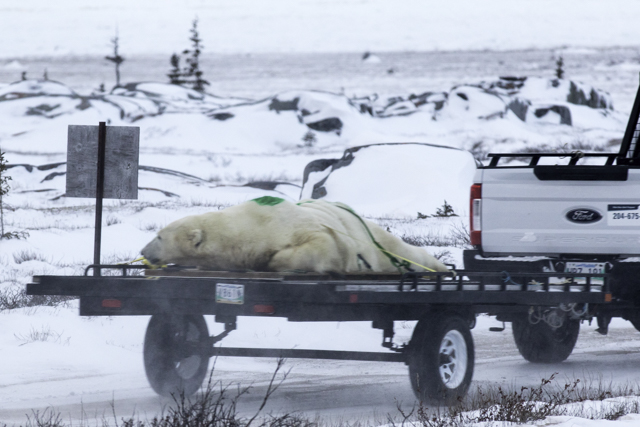
The first amazing experience happened a few hours after our arrival to Churchill. Fellow guide Theresa Whipple spotted a polar bear alert truck towing a trailer with a sedated giant male bear on the back heading east from the polar bear jail. She called me on the radio and we headed out there. Brad Josephs photo.
This last polar bear season proved to be quite challenging after the first week of November due to record-setting early cold weather which caused the sea-ice to form earlier than it has in decades. This was such a different situation from last year when the ice formed unusually late. This, of course, is great news for the polar bears, which need ice as a platform to hunt seals, but when the bears move offshore we cannot find them on our bear viewing trips. I and two other guides were scheduled with the last trips of the season, extending until the 26th of November. These new “family trips” would have been spectacular last year, but this year most of the bears had moved to more than 60 miles offshore, which is too far for us to even find with helicopters! We maintained a positive attitude and tried our best to teach the young kids in our groups as much as possible about Arctic ecology, and have as much fun as possible. Luckily these trips turned out to be fantastic, and we were privy to some outstanding and rarely seen bear action.
Since the early 1980s, the province of Manitoba has employed a force of bear patrol officers who haze polar bears away from town and incarcerate problem bears in the Polar Bear Holding Facility, aka the Polar Bear Jail. When the ice has formed on Hudson Bay, the officers release the bears on the beach outside of town. When the bears see the ice, they lose any interest in prowling around town and head offshore to hunt seals. In my 13 seasons guiding in Churchill, I have never witnessed these releases, though it has always been a dream of mine to see it.

We found several Polar Bear Alert Conservation Officers unloading two huge bears on the beach at the edge of the frozen sea. Brad Josephs photo.

The 1,000+ pound polar bear, immobilized with Telazol, was carefully rolled onto the beach. In 45 minutes he woke up and headed onto the ice. The green dot on his back lasts for around a week and shows anyone from a distance that the bear has recently been released. It also shows possible substance hunters from villages to the north that the bear has toxic drugs in his system from being immobilized, and shouldn’t be consumed. Brad Josephs photo.
The highlight of the entire trip for most of the group happened like magic. One of the officers came to our group in his truck and asked how many little kids we had. He knew with the bears having disappeared from town that we were going to have a rough time meeting the expectations of the kids. I couldn’t believe it when he told us to load the little ones in his truck so he could drive them up to the waking giant bear for a close look! What an amazing experience that these young guys would never forget. Brett, if you are out there, you are a hero in my book forever!
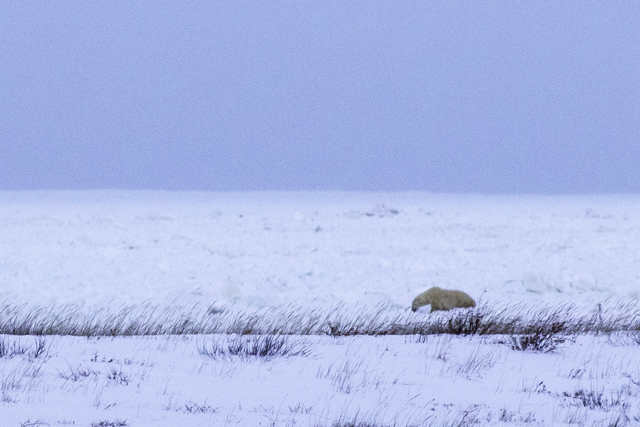
The bear is awake and moving around groggily after 45 minutes. He’s a FREE BEAR and theres ice to hunt on! Brad Josephs photo.
The next morning we all boarded helicopters to hopefully see bears on the ice. Since the ice edge was an estimated 60 miles offshore, we knew that we may not find any, as we cannot travel that far by helicopter. We were so happy to see many bears! To fly over that vast expanse of rugged ice and finally reach the bears who were hunting seals was for me, a lifetime wildlife viewing highlight. We even saw one of the bears that had been released the previous evening, already more than 10 miles offshore! The climax was seeing a bear eating a seal. WOW doesn’t describe it!
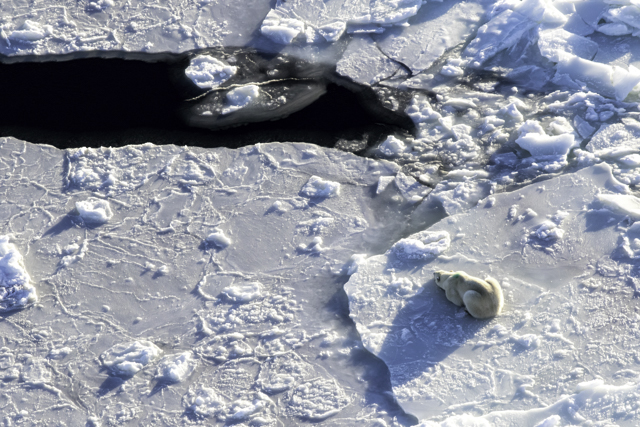
The green dot shows us this bear was released the evening before! The next morning we see him waiting next to a patch of open water, watching for seals! Brad Josephs photo.
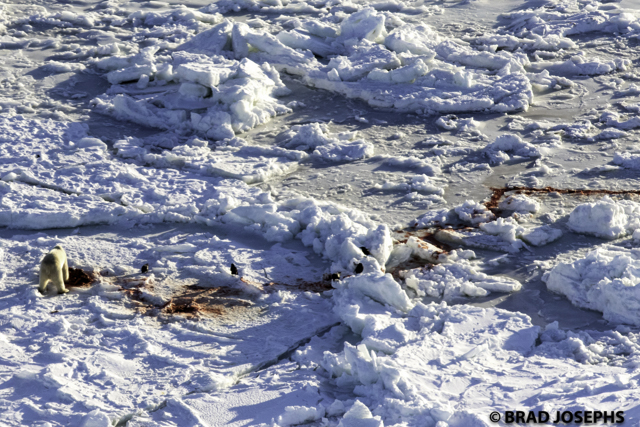
We found this young bear who had very recently caught a seal from a breathing hole, dragged it to more solid ice, and was happily devouring the blubber. Brad Josephs photo.
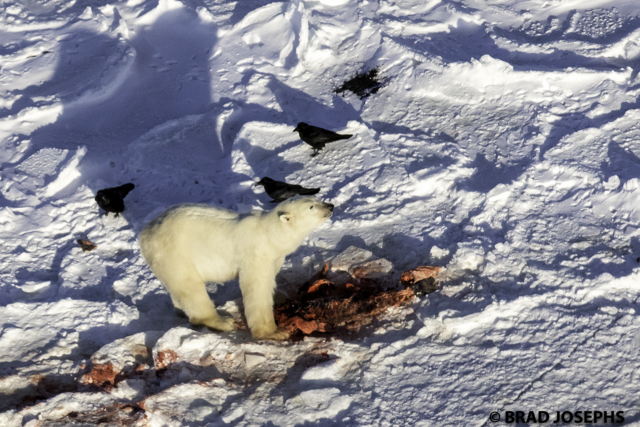
I was thrilled to see ravens with the bears. These tough birds, as well as arctic foxes, travel hundreds of miles onto the pack ice to scavenge seal kills. I wonder if the ravens help the bears find breathing holes—I bet they do. Brad Josephs photo.
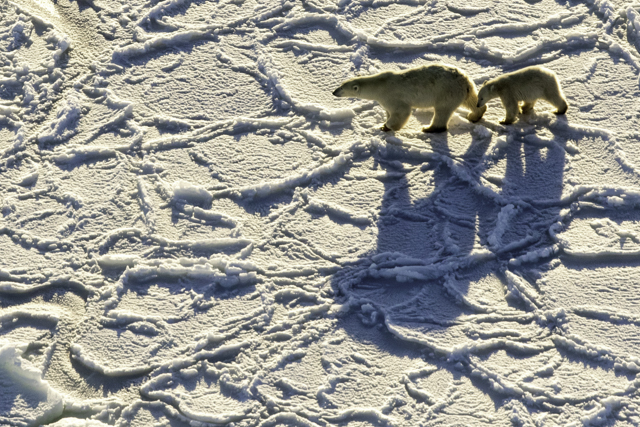
Mom and cub searching for seals on the ice. Brad Josephs photo.
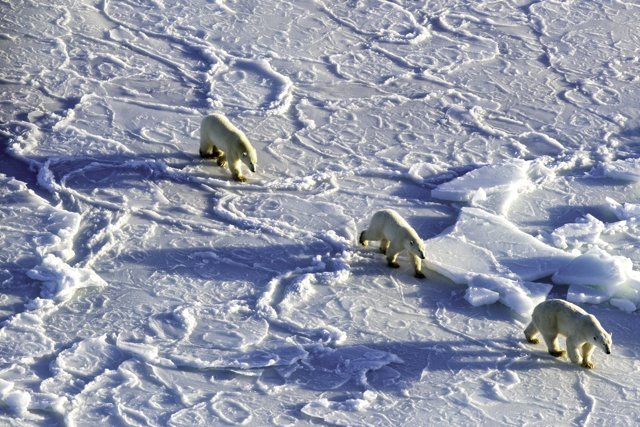
Mom and two 2-year-old cubs. Brad Josephs photo.
When our helicopter trip was finished the pilot said the conservation officers needed helicopter assistance with a problem bear in town. We loaded the bus and sat at a high point in town and waited for the action, and found it though it was a little too close for comfort, but very exciting for the kids.
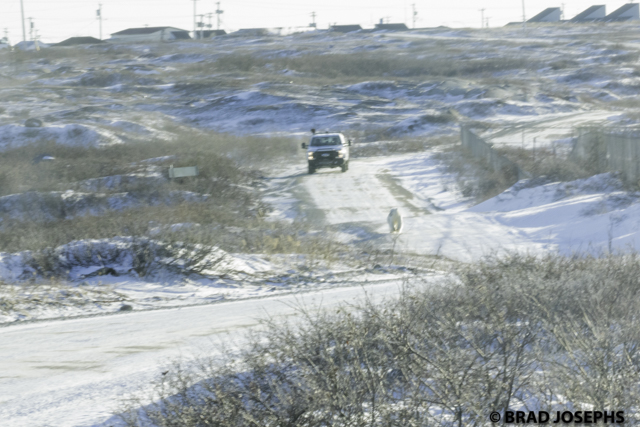
Polar bear alert chases a cub out of town. The bear raced down the road towards us. We had to move the bus to get out of the way. Some of my folks said it was like being in the middle of a James Bond movie, as the helicopter hovered over us, and the bear was darted by an officer hanging from an open window. Brad Josephs photo.

Officers immobilized the orphaned 1-year-old cub from the helicopter with a dart. The cub’s chance of survival in the wild is south of zero at that age, so he will be transferred to the polar bear exhibit at the Winnipeg Zoo most likely. Brad Josephs photo.

Jack Batskill is a legendary Polar Bear Alert officer. Through his many years of dealing with polar bears, he is revered as a leading expert in his field, and respected by all in the bear world. Brad Josephs photo.
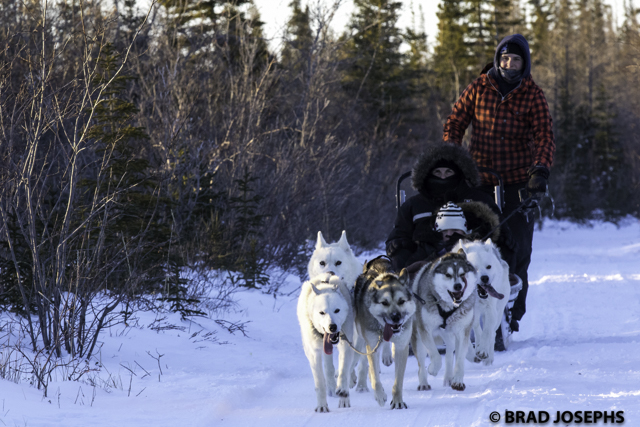
Dog sledding in the boreal forest. Brad Josephs photo.

I found a snowshoe hare in the boreal forest for the kids to see. Brad Josephs photo.
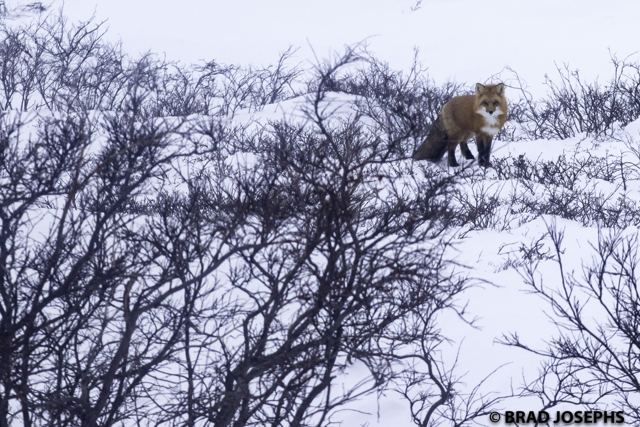
On the last day we explored the tundra in a Polar Rover. We didn’t see any bears, but after the action of the previous days it was OK. The kids understood, and we had a blast looking for foxes and other wildlife. This is a red fox. Brad Josephs photo.
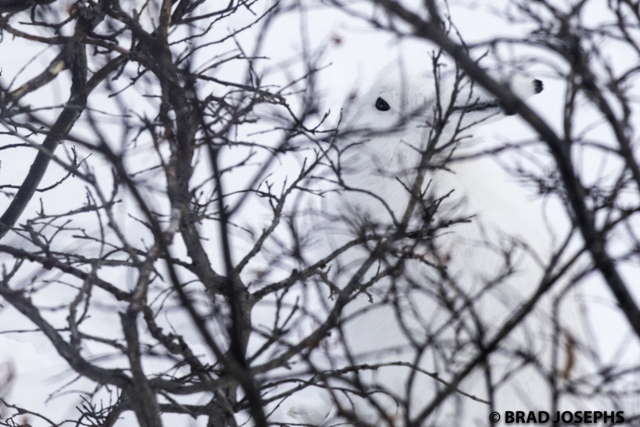
12-year-old Eleanor Fraser won my “animal spotter award” for seeing this nearly invisible arctic hare in a willow patch. Way to go, Eleanor! Brad Josephs photo.
What an awesome trip! I am so glad it was so thrilling for the kids, as getting the young generation interested in our natural world is the only way to ensure conservation in the future.
Check out Natural Habitat’s new family trips if you want to take your kids on an educational adventure that is parent and kid friendly. Let us plant seeds of appreciation for the natural world in the young ones and encourage a new generation of conservationists!
Keep exploring! Brad
by Steve Selden | Dec 13, 2017 | Churchill Photography

While most if not all voracious polar bears have ventured out to the sea ice for seal hunting season, foxes both Arctic and Red are still scavenging the tundra around communities in the north. This precocious little critter waits at the bus stop unfazed by any sign of human activity. Foxes never stop searching out their next meal during the harsh, cold winter months in the Arctic.
by Steve Selden | Jun 27, 2016 | Churchill Photography
Sea – ice is still in the frigid waters close to Churchill’s coast and these hearty travelers have been exploring via zodiac and Sea North Tours. I always looked forward to the early and exciting Churchill Arctic summer season with ice floes remaining in the Churchill River out into the Hudson Bay. These awesome features provide an extra thrill factor with Arctic terns and various other sea birds perching on the jagged ice chunks atop the floes. Even an occasional seal will nap on the ice surface. The surrealistic mix of sun, sea and ice combines to form a sub – Arctic natural environment at its best!

Beautiful blue pools within a massive ice floe near Churchill. Alex De Vries – Magnifico photo.
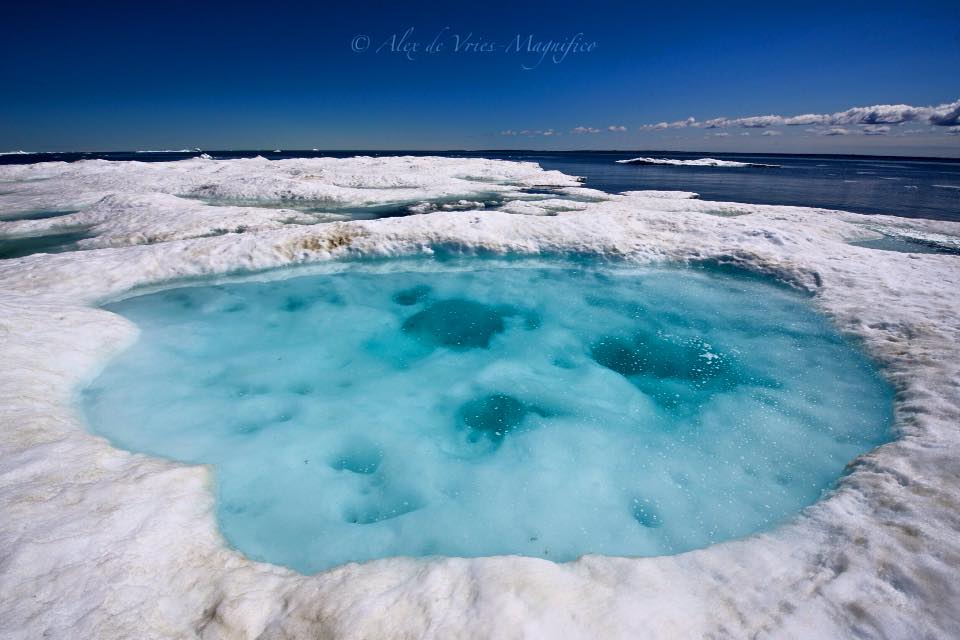
Blue azure pool on an ice floe near Churchill. Alex De Vries – Magnifico photo.
























